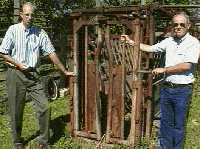Handling Facilities Help Reduce Farm Accidents
Handling Facilities Help Reduce Farm Accidents

The Kentucky farm community has seen more than its usual share of fatalities due to livestock injuries over the last couple of months, but dozens of other accidents resulting in bumps, bruises and broken bones to humans and livestock are a common occurrence around some livestock operations.
"If you get into a shoving match with a 1,400 pound heifer who is separated from her calf or a skittish steer, you know who is going to lose," said Larry Piercy, Extension safety and health specialist in the UK College of Agriculture.
"The most dangerous times are when producers are trying to load cattle on trucks or attempting to treat animals... especially if they don't have the right facilities," warns Piercy.
The best way to reduce or eliminate this safety problem is to invest in a well planned cattle handling facility.
"One of the worst mistakes that a producer can make is to have no working facility at all," said Larry Turner, Extension Ag Engineer in the UK College of Agriculture. "That is both an economic mistake and a safety mistake and one that they shouldn't be making."
Turner noted that at any level of production, some sort of cattle handling facility is a good investment.
"A producer with a cow-calf operation of just 30 head of livestock can still afford to invest in a head gate, squeeze chute and some form of gated corral fencing to funnel the animals to the facility.
With that kind of basic system, a producer can easily carry out such cost effective procedures as worming, dehorning, shots, castration and other health maintenance measures.
The payback is a safe and efficient work environment and healthier, more productive animals that bring better returns at sale time.
"Almost all the components of the working facility can be built on the farm. The only exception to that would be the head catch which should be purchased commercially," said Turner.
"The rest of a facility can be made from materials that are usually available such as wood posts, plywood and/or metal poles or pipe," said Turner.
A variety of head catches are available. They range in price from $250-500. Each has it's own set of strengths and weaknesses.
The basic handling system should also include solid-sided chutes that keep cattle from getting distracted by side views that may in turn spook the animals into striking out and injuring a handler or hurting themselves.
The chute should also be narrow enough so that cattle cannot turn and block the pathway which might force the producer to get in the pen and work at dangerously close quarters with the animals.
The system becomes even more producer friendly if such items as man pass gates and twin posts used as escape zones that the producer can use to keep from having to come into direct contact with the animal.
"The UK Ag Engineering department also has plans for pasture fencing and corral systems that funnel a herd into a smaller area and then provide ways to separate animals for specialized processing with minimal danger to the herder and animals themselves," said Turner.
Cooperative Extension service agents for agriculture have access to fact sheets, blueprints and videotapes that can help individual producers design and construct a safe livestock handling facility.
"While the main concern may be with adults who are working with farm animals, lets not forget the kids," said Piercy. "Insure that these young people learn to respect the power of the larger animals and insist that they learn some basic handling techniques before they are allowed to carry out chores on their own," said Piercy.
-30-
